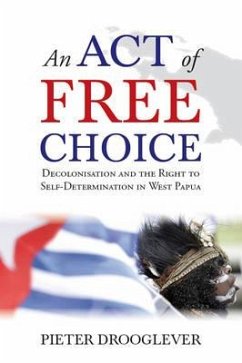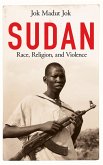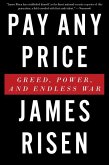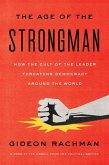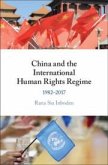Pieter Drooglever
An Act of Free Choice
Decolonisation and the Right to Self-Determination in West Papua
Pieter Drooglever
An Act of Free Choice
Decolonisation and the Right to Self-Determination in West Papua
- Gebundenes Buch
- Merkliste
- Auf die Merkliste
- Bewerten Bewerten
- Teilen
- Produkt teilen
- Produkterinnerung
- Produkterinnerung
This important study introduces the history and people of West Papua, tracing the origins of the international conflict surrounding their struggle for self-determination following the Second World War. Based on three decades of exhaustive research and focusing particular attention on the sham referendum of 1969 - which Indonesia dubbed 'The Act of Free Choice', an election rigged to legitimize Indonesian control over West Papua - Droogleever highlights the continuing impact of this injustice on Indonesia's most underdeveloped and poverty-stricken province.
Andere Kunden interessierten sich auch für
![Sudan Sudan]() Jok Madut JokSudan17,99 €
Jok Madut JokSudan17,99 €![Ten Lessons for a Post-Pandemic World Ten Lessons for a Post-Pandemic World]() Fareed ZakariaTen Lessons for a Post-Pandemic World21,99 €
Fareed ZakariaTen Lessons for a Post-Pandemic World21,99 €![Pay Any Price Pay Any Price]() James RisenPay Any Price18,99 €
James RisenPay Any Price18,99 €![The Age of the Strongman: How the Cult of the Leader Threatens Democracy Around the World The Age of the Strongman: How the Cult of the Leader Threatens Democracy Around the World]() Gideon RachmanThe Age of the Strongman: How the Cult of the Leader Threatens Democracy Around the World24,99 €
Gideon RachmanThe Age of the Strongman: How the Cult of the Leader Threatens Democracy Around the World24,99 €![Together We Rise Together We Rise]() The Women's March OrganizersTogether We Rise26,99 €
The Women's March OrganizersTogether We Rise26,99 €![China and the International Human Rights Regime China and the International Human Rights Regime]() Rana Siu InbodenChina and the International Human Rights Regime108,99 €
Rana Siu InbodenChina and the International Human Rights Regime108,99 €![The Choice for Europe The Choice for Europe]() Andrew MoravcsikThe Choice for Europe83,99 €
Andrew MoravcsikThe Choice for Europe83,99 €-
-
-
This important study introduces the history and people of West Papua, tracing the origins of the international conflict surrounding their struggle for self-determination following the Second World War. Based on three decades of exhaustive research and focusing particular attention on the sham referendum of 1969 - which Indonesia dubbed 'The Act of Free Choice', an election rigged to legitimize Indonesian control over West Papua - Droogleever highlights the continuing impact of this injustice on Indonesia's most underdeveloped and poverty-stricken province.
Hinweis: Dieser Artikel kann nur an eine deutsche Lieferadresse ausgeliefert werden.
Hinweis: Dieser Artikel kann nur an eine deutsche Lieferadresse ausgeliefert werden.
Produktdetails
- Produktdetails
- Verlag: Oneworld Publications
- Seitenzahl: 854
- Erscheinungstermin: 16. März 2010
- Englisch
- Abmessung: 244mm x 161mm x 53mm
- Gewicht: 1490g
- ISBN-13: 9781851687152
- ISBN-10: 1851687157
- Artikelnr.: 28895526
- Herstellerkennzeichnung
- Libri GmbH
- Europaallee 1
- 36244 Bad Hersfeld
- gpsr@libri.de
- Verlag: Oneworld Publications
- Seitenzahl: 854
- Erscheinungstermin: 16. März 2010
- Englisch
- Abmessung: 244mm x 161mm x 53mm
- Gewicht: 1490g
- ISBN-13: 9781851687152
- ISBN-10: 1851687157
- Artikelnr.: 28895526
- Herstellerkennzeichnung
- Libri GmbH
- Europaallee 1
- 36244 Bad Hersfeld
- gpsr@libri.de
Pieter Drooglever was the lead researcher on a government-sponsored, 27-year study of the decolonisation of Indonesia at the Institute of Netherlands History at The Hague. He also served as chairman of the historical committee for Indonesian Studies, and was a lecturer in Indonesian History at the University of Nymegen, where he held the L.J. Rogier chair.
Preface
Illustrations
Map: Netherlands New Guinea c. 1960
1 A Distant Corner of the Netherlands East Indies
The Dutch East India Company (DEIC), Tidore and New Guinea
The eastern frontier of the Netherlands East Indies
Establishing control and exploring the interior
Administrative policies up to the Second World War
The Protestant and Catholic Missions
The 'mise en valeur': business and colonists
Looking back
2 The Shock of War
West New Guinea during the Second World War
The way back
New Guinea under the Japanese occupation
The restoration of government under Van Eechoud
Echoes of the revolution
3 New Guinea as a Bargaining Tool
Indonesia becomes independent
The nationalists take the helm
Political relations in the Netherlands
The federal response
Linggadjati; talks and clashes
A poker game between Bandung, Yogya and The Hague
Claims on New Guinea
The Republicans' wishes
Malino and the Moluccan Commonwealth
The Indo-European option and the Papuan cause
Passing the Papuans from player to player
Dutch moves
East Indonesian aspirations
Republican reactions
Two Dutch pickets
New Guinea and the Decree on the Government of Indonesia during the
Period of Transition
The removal of Tidoran home rule on New Guinea
4 Separation from Indonesia
Minister Van Maarseveen steps into the limelight
The covert hand of Hollandia
The Round Table Conference
Players from the side-lines
Arguments, circumstances and motives
5 Locking Horns
The Netherlands and Indonesia in the 'status-quo' year
New Guinea in cold storage
The Supomo mission
Ali Sastroamidjojo's offensive
The Geneva Conference
6 Direct Rule from The Hague
A new system of government
Regaining momentum under Van Waardenburg
Two Calvinist comrades in power
For the sake of the Papuans' education
Changed conditions in Protestant circles
The arrival of the American and Australian missions
A new place for the Roman Catholics
Education
Language policy
The hesitations of big business
A development project under the colonial flag
Territorial extension of the administration
7 The Dispute in an International Perspective
The hounds are loose
The superpowers and the place of the United Nations
Consultations with Australia
American guarantees
An arms race at the equator
The points of departure
The Indonesian military build-up from 1958 onward
The Karel Doorman's odyssey
8 The Turning Tide in The Hague and Washington
The crumbling home front
De Quay takes office
The first steps on the path to internationalization
Minister Luns and the General Assembly of 1960
Tunku Abdul Rahman's mediation attempt
Bright boys in Washington
Further commotion on the home front
The conception of the Luns plan
The Luns plan in the General Assembly of 1961
9 The Metamorphoses of the Luns Plan
The Dutch Cabinet's definition of its position
Talking under pressure
The military situation
American diplomatic assistance
The dispute about the preconditions
Washington's 'knock on the head'
Kennedy nails his colours to the mast
Ambassador Bunker's plan
Back to Middleburg
The New York Agreement
The Indonesian approach
Van Roijen and Malik get down to business
The making of the New York Agreement
The last hurdles
10 Democratization Under Bot and Platteel
New Guinea; reactions of the government and the population
The democratization of the administration
Town and Regional Councils
The New Guinea Council
Forming Parties
11 Papua Blues
The New Guinea Council and the political parties
The forming of the National Committee: Flag and Anthem
The Luns Plan in the New Guinea Council
Bitter travel experiences
Jitters in New Guinea
The political stance of the Papuans in 1962
Contacts with the Eastern neighbours
Contacts with African countries
Members of the New Guinea Council visit The Hague
A proclamation of independence?
The final months under the red-white-and-blue
12 Under Jakarta's Thumb
The entry of the UNTEA
Under one roof with the UNTEA and Indonesia
Indonesia as temporary administrator
Build-up to the plebiscite
Between Delft, Manokwari and New York
13 The First Phase of the Act of Free Choice
Preliminary manoeuvres
The task of the United Nations
The appointment of Ortiz Sanz
Defining positions in The Hague, Jakarta and Washington
Ortiz Sanz's first steps
Interim consultations in The Hague and New York
The further development of the Indonesian plans
Papuans in action
Resistance
Diplomacy
14 The Second Phase of the Act of Free Choice
Luns, Udink and Malik to Rome
The composition of the consultative councils
Self-determination in practice
Reporting to the United Nations
Looking back in the Netherlands
Conclusion
Appendix
Notes
Bibliography
Index
Illustrations
Map: Netherlands New Guinea c. 1960
1 A Distant Corner of the Netherlands East Indies
The Dutch East India Company (DEIC), Tidore and New Guinea
The eastern frontier of the Netherlands East Indies
Establishing control and exploring the interior
Administrative policies up to the Second World War
The Protestant and Catholic Missions
The 'mise en valeur': business and colonists
Looking back
2 The Shock of War
West New Guinea during the Second World War
The way back
New Guinea under the Japanese occupation
The restoration of government under Van Eechoud
Echoes of the revolution
3 New Guinea as a Bargaining Tool
Indonesia becomes independent
The nationalists take the helm
Political relations in the Netherlands
The federal response
Linggadjati; talks and clashes
A poker game between Bandung, Yogya and The Hague
Claims on New Guinea
The Republicans' wishes
Malino and the Moluccan Commonwealth
The Indo-European option and the Papuan cause
Passing the Papuans from player to player
Dutch moves
East Indonesian aspirations
Republican reactions
Two Dutch pickets
New Guinea and the Decree on the Government of Indonesia during the
Period of Transition
The removal of Tidoran home rule on New Guinea
4 Separation from Indonesia
Minister Van Maarseveen steps into the limelight
The covert hand of Hollandia
The Round Table Conference
Players from the side-lines
Arguments, circumstances and motives
5 Locking Horns
The Netherlands and Indonesia in the 'status-quo' year
New Guinea in cold storage
The Supomo mission
Ali Sastroamidjojo's offensive
The Geneva Conference
6 Direct Rule from The Hague
A new system of government
Regaining momentum under Van Waardenburg
Two Calvinist comrades in power
For the sake of the Papuans' education
Changed conditions in Protestant circles
The arrival of the American and Australian missions
A new place for the Roman Catholics
Education
Language policy
The hesitations of big business
A development project under the colonial flag
Territorial extension of the administration
7 The Dispute in an International Perspective
The hounds are loose
The superpowers and the place of the United Nations
Consultations with Australia
American guarantees
An arms race at the equator
The points of departure
The Indonesian military build-up from 1958 onward
The Karel Doorman's odyssey
8 The Turning Tide in The Hague and Washington
The crumbling home front
De Quay takes office
The first steps on the path to internationalization
Minister Luns and the General Assembly of 1960
Tunku Abdul Rahman's mediation attempt
Bright boys in Washington
Further commotion on the home front
The conception of the Luns plan
The Luns plan in the General Assembly of 1961
9 The Metamorphoses of the Luns Plan
The Dutch Cabinet's definition of its position
Talking under pressure
The military situation
American diplomatic assistance
The dispute about the preconditions
Washington's 'knock on the head'
Kennedy nails his colours to the mast
Ambassador Bunker's plan
Back to Middleburg
The New York Agreement
The Indonesian approach
Van Roijen and Malik get down to business
The making of the New York Agreement
The last hurdles
10 Democratization Under Bot and Platteel
New Guinea; reactions of the government and the population
The democratization of the administration
Town and Regional Councils
The New Guinea Council
Forming Parties
11 Papua Blues
The New Guinea Council and the political parties
The forming of the National Committee: Flag and Anthem
The Luns Plan in the New Guinea Council
Bitter travel experiences
Jitters in New Guinea
The political stance of the Papuans in 1962
Contacts with the Eastern neighbours
Contacts with African countries
Members of the New Guinea Council visit The Hague
A proclamation of independence?
The final months under the red-white-and-blue
12 Under Jakarta's Thumb
The entry of the UNTEA
Under one roof with the UNTEA and Indonesia
Indonesia as temporary administrator
Build-up to the plebiscite
Between Delft, Manokwari and New York
13 The First Phase of the Act of Free Choice
Preliminary manoeuvres
The task of the United Nations
The appointment of Ortiz Sanz
Defining positions in The Hague, Jakarta and Washington
Ortiz Sanz's first steps
Interim consultations in The Hague and New York
The further development of the Indonesian plans
Papuans in action
Resistance
Diplomacy
14 The Second Phase of the Act of Free Choice
Luns, Udink and Malik to Rome
The composition of the consultative councils
Self-determination in practice
Reporting to the United Nations
Looking back in the Netherlands
Conclusion
Appendix
Notes
Bibliography
Index
Preface
Illustrations
Map: Netherlands New Guinea c. 1960
1 A Distant Corner of the Netherlands East Indies
The Dutch East India Company (DEIC), Tidore and New Guinea
The eastern frontier of the Netherlands East Indies
Establishing control and exploring the interior
Administrative policies up to the Second World War
The Protestant and Catholic Missions
The 'mise en valeur': business and colonists
Looking back
2 The Shock of War
West New Guinea during the Second World War
The way back
New Guinea under the Japanese occupation
The restoration of government under Van Eechoud
Echoes of the revolution
3 New Guinea as a Bargaining Tool
Indonesia becomes independent
The nationalists take the helm
Political relations in the Netherlands
The federal response
Linggadjati; talks and clashes
A poker game between Bandung, Yogya and The Hague
Claims on New Guinea
The Republicans' wishes
Malino and the Moluccan Commonwealth
The Indo-European option and the Papuan cause
Passing the Papuans from player to player
Dutch moves
East Indonesian aspirations
Republican reactions
Two Dutch pickets
New Guinea and the Decree on the Government of Indonesia during the
Period of Transition
The removal of Tidoran home rule on New Guinea
4 Separation from Indonesia
Minister Van Maarseveen steps into the limelight
The covert hand of Hollandia
The Round Table Conference
Players from the side-lines
Arguments, circumstances and motives
5 Locking Horns
The Netherlands and Indonesia in the 'status-quo' year
New Guinea in cold storage
The Supomo mission
Ali Sastroamidjojo's offensive
The Geneva Conference
6 Direct Rule from The Hague
A new system of government
Regaining momentum under Van Waardenburg
Two Calvinist comrades in power
For the sake of the Papuans' education
Changed conditions in Protestant circles
The arrival of the American and Australian missions
A new place for the Roman Catholics
Education
Language policy
The hesitations of big business
A development project under the colonial flag
Territorial extension of the administration
7 The Dispute in an International Perspective
The hounds are loose
The superpowers and the place of the United Nations
Consultations with Australia
American guarantees
An arms race at the equator
The points of departure
The Indonesian military build-up from 1958 onward
The Karel Doorman's odyssey
8 The Turning Tide in The Hague and Washington
The crumbling home front
De Quay takes office
The first steps on the path to internationalization
Minister Luns and the General Assembly of 1960
Tunku Abdul Rahman's mediation attempt
Bright boys in Washington
Further commotion on the home front
The conception of the Luns plan
The Luns plan in the General Assembly of 1961
9 The Metamorphoses of the Luns Plan
The Dutch Cabinet's definition of its position
Talking under pressure
The military situation
American diplomatic assistance
The dispute about the preconditions
Washington's 'knock on the head'
Kennedy nails his colours to the mast
Ambassador Bunker's plan
Back to Middleburg
The New York Agreement
The Indonesian approach
Van Roijen and Malik get down to business
The making of the New York Agreement
The last hurdles
10 Democratization Under Bot and Platteel
New Guinea; reactions of the government and the population
The democratization of the administration
Town and Regional Councils
The New Guinea Council
Forming Parties
11 Papua Blues
The New Guinea Council and the political parties
The forming of the National Committee: Flag and Anthem
The Luns Plan in the New Guinea Council
Bitter travel experiences
Jitters in New Guinea
The political stance of the Papuans in 1962
Contacts with the Eastern neighbours
Contacts with African countries
Members of the New Guinea Council visit The Hague
A proclamation of independence?
The final months under the red-white-and-blue
12 Under Jakarta's Thumb
The entry of the UNTEA
Under one roof with the UNTEA and Indonesia
Indonesia as temporary administrator
Build-up to the plebiscite
Between Delft, Manokwari and New York
13 The First Phase of the Act of Free Choice
Preliminary manoeuvres
The task of the United Nations
The appointment of Ortiz Sanz
Defining positions in The Hague, Jakarta and Washington
Ortiz Sanz's first steps
Interim consultations in The Hague and New York
The further development of the Indonesian plans
Papuans in action
Resistance
Diplomacy
14 The Second Phase of the Act of Free Choice
Luns, Udink and Malik to Rome
The composition of the consultative councils
Self-determination in practice
Reporting to the United Nations
Looking back in the Netherlands
Conclusion
Appendix
Notes
Bibliography
Index
Illustrations
Map: Netherlands New Guinea c. 1960
1 A Distant Corner of the Netherlands East Indies
The Dutch East India Company (DEIC), Tidore and New Guinea
The eastern frontier of the Netherlands East Indies
Establishing control and exploring the interior
Administrative policies up to the Second World War
The Protestant and Catholic Missions
The 'mise en valeur': business and colonists
Looking back
2 The Shock of War
West New Guinea during the Second World War
The way back
New Guinea under the Japanese occupation
The restoration of government under Van Eechoud
Echoes of the revolution
3 New Guinea as a Bargaining Tool
Indonesia becomes independent
The nationalists take the helm
Political relations in the Netherlands
The federal response
Linggadjati; talks and clashes
A poker game between Bandung, Yogya and The Hague
Claims on New Guinea
The Republicans' wishes
Malino and the Moluccan Commonwealth
The Indo-European option and the Papuan cause
Passing the Papuans from player to player
Dutch moves
East Indonesian aspirations
Republican reactions
Two Dutch pickets
New Guinea and the Decree on the Government of Indonesia during the
Period of Transition
The removal of Tidoran home rule on New Guinea
4 Separation from Indonesia
Minister Van Maarseveen steps into the limelight
The covert hand of Hollandia
The Round Table Conference
Players from the side-lines
Arguments, circumstances and motives
5 Locking Horns
The Netherlands and Indonesia in the 'status-quo' year
New Guinea in cold storage
The Supomo mission
Ali Sastroamidjojo's offensive
The Geneva Conference
6 Direct Rule from The Hague
A new system of government
Regaining momentum under Van Waardenburg
Two Calvinist comrades in power
For the sake of the Papuans' education
Changed conditions in Protestant circles
The arrival of the American and Australian missions
A new place for the Roman Catholics
Education
Language policy
The hesitations of big business
A development project under the colonial flag
Territorial extension of the administration
7 The Dispute in an International Perspective
The hounds are loose
The superpowers and the place of the United Nations
Consultations with Australia
American guarantees
An arms race at the equator
The points of departure
The Indonesian military build-up from 1958 onward
The Karel Doorman's odyssey
8 The Turning Tide in The Hague and Washington
The crumbling home front
De Quay takes office
The first steps on the path to internationalization
Minister Luns and the General Assembly of 1960
Tunku Abdul Rahman's mediation attempt
Bright boys in Washington
Further commotion on the home front
The conception of the Luns plan
The Luns plan in the General Assembly of 1961
9 The Metamorphoses of the Luns Plan
The Dutch Cabinet's definition of its position
Talking under pressure
The military situation
American diplomatic assistance
The dispute about the preconditions
Washington's 'knock on the head'
Kennedy nails his colours to the mast
Ambassador Bunker's plan
Back to Middleburg
The New York Agreement
The Indonesian approach
Van Roijen and Malik get down to business
The making of the New York Agreement
The last hurdles
10 Democratization Under Bot and Platteel
New Guinea; reactions of the government and the population
The democratization of the administration
Town and Regional Councils
The New Guinea Council
Forming Parties
11 Papua Blues
The New Guinea Council and the political parties
The forming of the National Committee: Flag and Anthem
The Luns Plan in the New Guinea Council
Bitter travel experiences
Jitters in New Guinea
The political stance of the Papuans in 1962
Contacts with the Eastern neighbours
Contacts with African countries
Members of the New Guinea Council visit The Hague
A proclamation of independence?
The final months under the red-white-and-blue
12 Under Jakarta's Thumb
The entry of the UNTEA
Under one roof with the UNTEA and Indonesia
Indonesia as temporary administrator
Build-up to the plebiscite
Between Delft, Manokwari and New York
13 The First Phase of the Act of Free Choice
Preliminary manoeuvres
The task of the United Nations
The appointment of Ortiz Sanz
Defining positions in The Hague, Jakarta and Washington
Ortiz Sanz's first steps
Interim consultations in The Hague and New York
The further development of the Indonesian plans
Papuans in action
Resistance
Diplomacy
14 The Second Phase of the Act of Free Choice
Luns, Udink and Malik to Rome
The composition of the consultative councils
Self-determination in practice
Reporting to the United Nations
Looking back in the Netherlands
Conclusion
Appendix
Notes
Bibliography
Index

